
Key Takeaways
- Twins separated at birth offer intriguing insights into the nature vs. nurture debate. Despite being raised in different environments, they can showcase remarkable similarities in personality, preferences and life choices.
- Documented cases, like the Jim twins, who lived parallel lives without knowledge of each other, highlight the profound impact of genetics on human behavior and identity.
- Studies and stories of reunited twins contribute to our understanding of human development, emphasizing the complex interplay between genetic predispositions and environmental influences.
Twins, by their very two-for-one nature, are a historically and scientifically fascinating phenomenon. Start with, say, Cain and Abel, who may or may not have been twins, depending on your biblical bent. Roll right up to Romulus and Remus, who founded Rome in a mythological kind of way. Zip through Mary-Kate and Ashley, who we're sure have done something lately, and the Winklevosses, who founded Facebook evidently before there even was a Facebook. However you look at them, twins have made their mark on the world.
Scientists have long recognized that and have taken to studying twins (and other multiple births, like triplets) to uncover their mysteries. The Minnesota Twin Family Study (MTFS), perhaps the most well-known of the research, officially has been giving twins the twice over since 1987, and other studies in Minnesota and elsewhere preceded that one. Almost 10,000 people have taken part in the MTFS, which, it says, aims to uncover "how genes and environment interact to influence character, strengths, vulnerabilities and values."
Advertisement
Some of the most intriguing, mind-blowing stories concerning the "genes and environment" debate — the age-old argument of "nature vs. nurture" — come when siblings are separated at birth.
Elizabeth Hamel and Ann Hunt, for a fraternal twin example, spent 78 years apart after being separated at birth. When they finally reunited in 2014 — one lived in Oregon, the other in the U.K. — the nature-nurture crowd went wild over the striking similarities (and marked differences) between the two genetically alike but geographically diverse sisters.
Both Elizabeth and Ann were widowed. Both had husbands named Jim. Both are religious and like to cut up for the camera.
"Fascinating work on separated twins shows that here are twins growing up in totally different families, sometimes even totally different cultures, and yet they bring with them similar types of attitudes — in politics, religion, social behaviour," psychologist Nancy Segal, director of the Twin Studies Center at California State University-Fullerton, told the BBC. "Where do these things come from? It's difficult to know exactly but it seems that their genes linked to intelligence, personality and temperament just lead them to have similar types of world views."
Here are five more examples of siblings separated at birth who found each other years later.


